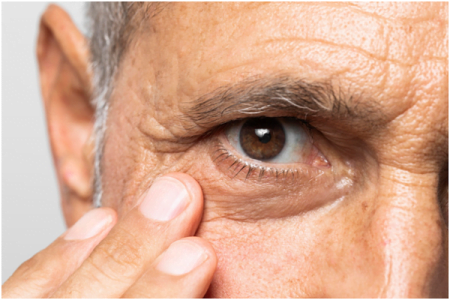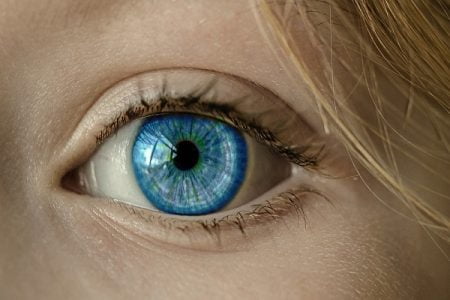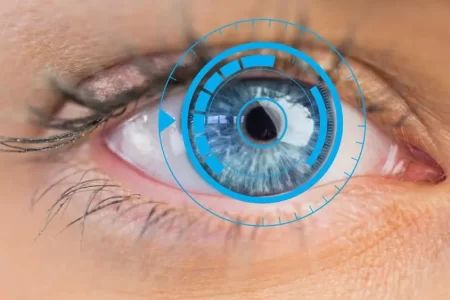
Keratoconus – Definition and Overview
The term “Keratoconus” is a combination of two greek words. “Kerato” is the word for cornea and “konos” means cones.
Keratoconus is a non-inflammatory condition in which cornea progressively thins and bulges outward into a shape of a cone. This process of reshaping cornea is known as corneal ectasia. Keratoconus is a bilateral ocular disorder and may affect each eye differently.
Cornea is a clear, round or dome-shaped central part of the front surface of the eye. Cornea helps in refraction (bending) of light rays and focuses the light rays onto the retina. The irregular or distorted shaped of cornea prevents the light rays from focusing correctly on the retina which leads to keratoconus.
What happens in keratoconus: Can you go blind if you have keratoconus?
Keratoconus causes blurred vision, double vision, nearsightedness or myopia, astigmatism, and sensitivity towards light. In severe cases, scarring (appearance of a circular structures) is observed within the cornea. The structure of the cornea, sometimes, is not sufficiently strong enough to hold on to its round shape (dome structure) which can also result in keratoconus.
Keratoconus is an unpredictable disorder and depicts no early symptoms. The progression of keratoconus is slow and can stop at any stage. Keratoconus rarely causes blindness. During its early stages, it results in slightly blurred and distorted vision.
Keratoconus can also be linked to other medical conditions, such as glaucoma, hay fever and sleep apnea.
Keratoconus can be diagnosed in young people (at puberty or in their late teens) and in middle age (about 45years of age) people. In some cases, Keratoconus can also be diagnosed at a later age, as the symptoms can be very mild (due to slow occurrence). Occurrence of keratoconus is independent of any specific geographic, cultural or social patterns but can be observed more in isolated populations. It is an extremely rare disorder with about 0.001% chances to occur in a population of 1000 people.
Signs and symptoms of keratoconus
The symptoms of keratoconus progress very slowly. During the early stage of keratoconus, the symptoms of keratoconus are majorly similar to that of any other refractive eye disease. The signs and symptoms are:
- The perception of multiple “ghost” images, known as monocular polyopia. “Ghost” images refer to the appearance of several images (double vision in one eye) while looking at one object.
- Distorted and blurred vision (at all distances)
- Poor night vision
- Sensitivity towards light (increased photophobia)
- Strain and pain in eyes
- Worsening of vision in one eye
- Nearsightedness (myopia) may develop slowly
- Irregular astigmatism may develop (when the eye cannot focus as it should).
- Frequent changes in eyeglass prescriptions i.e. deteriorating vision (usually in late adolescence).
Risk factors for keratoconus
Keratoconus is a “multi-factorial” disease i.e. it results from the interaction of multiple factors such as environmental, behavioral and genetic factors. The risk factors for keratoconus can be:
Family History: Is Keratoconus inherited?
Keratoconus is a genetically transmitted disorder (in some cases). About 15% of all the patients suffering with keratoconus have some kind of genetic history. It is a rare disorder but can sometimes affect more than one member in a family.
Six genes are found to have some link with the occurrence of keratoconus such as BANP-ZNF469, COL4A4, FOXO1, FNDC3B, IMMP2L and RXRA-COL5A1.
Environmental and behavioural factors
Hay fever, asthma or certain environmental allergies can sometimes increase the risk of keratoconus.
Chronic rubbing of eye might also trigger the condition. Rubbing might tip off the cornea leading to worsening of the thinning and bulging process of keratoconus.
Other diseases and conditions that can increase the risk of Keratoconus
Although keratoconus usually occurs independently, but there are certain diseases such as diabetes, Down’s syndrome, Marfan syndrome, Ehlers-Danlos syndrome, monosomia X (Turner syndrome), Leber’s congenital amaurosis, retinitis pigmentosa , collagenosis, mitral valve prolapse, etc that can be associated it. The presence of any of these diseases or disorders can increase the risk of keratoconus.
Causes of Keratoconus
The exact cause of keratoconus is presently unknown, but it appears that a genetic component or an environmental factor might initiate the process to cause the disease. There are some suspected causes of keratoconus which include:
- Injury or damage to the cornea
- Weakened corneal tissue (low levels of antioxidants weaken the collagen fibres)
- Excessive or vigorous rubbing of eye
- Poorly fitted contact lenses
- Heredity or family history
- Sometimes, an imbalance of enzymes or decrease in protective antioxidants within the cornea may cause oxidative damage from compounds (such as free radicals) resulting in the weakening and bulging out of the cornea. There is no evidence to support this theory, though.
Prevention of Keratoconus
The exact cause of keratoconus is unknown, so it cannot be prevented. To detect the disorder early, eye checkups should be done at regular intervals.
Diagnosis of Keratoconus
Early detection and diagnosis can prevent further damage to the eye leading to vision loss. These methods are typically used to diagnose keratoconus.
Eye examination for diagnosing keratoconus
During an eye exam, the symptoms and family medical history of the patient is carefully considered. This might help in diagnosing the correct cause of keratoconus.
Keratometer is used for the measurement of curvature of cornea and the extent of blurred vision (axis of the astigmatism). Often, keratometer might not result in the correct diagnosis of keratoconus.
Keratoscope for keratoconus diagnosis
Keratoscope technique is done by projecting a series of concentric rings of light on the surface of cornea. This is also known as keratometry. This technique is used during physical examination of the eye.
Retinoscopy
A light beam is focused on the retina and the “reflexes” are observed. Reflex is the reflection as the light beam is tilted back and forth. This is known as retinoscopy.
A scissor effect is created due to the reflexes as keratoconus exhibits two bands (which move towards and away from each other) like the blades of scissors do.
Slit-lamp exam
After keratoconus is suspected during the retinoscopy, slit lamp exam is performed. A vertical beam of light is directed on the eye surface and a low-powered microscope is used to evaluate the eye condition.
Slit-lamp exam is done to detect the correct shape of the cornea and to check for other potent characteristic problems of keratoconus, such as the Fleischer ring (a yellowish-brownish-greenish pigmentation) in the cornea.
Corneal topography for keratoconus diagnosis
Illuminated patterns are projected on the cornea to study the topology of cornea. It is also referred to as computerized corneal mapping and is done with the help of an automated instrument. Topography helps to study the relationship between cornea and other objects (near to it) sharing the same surface or border.
Corneal topography works best during the early stages of keratoconus, as any distortions or scars on the cornea can be clearly detected.
Stages of keratoconus
Keratoconus advances differently in each eye at different rates. Keratonocus progresses more rapidly at an early age. However, it can occur in people of age 40-50 and tends to stabilize after sometime.
Early keratoconus: stage 1 keratoconus
During stage 1 or the early stage of keratoconus, very slight corneal distortion is observed. The symptoms are extremely mild and therefore, sometimes, they cannot be detected. Keratoconus has little or sometimes no effect on the quality of vision and exhibit minimal or no progression.
Use of spectacles and soft contact lenses help in correcting myopia and astigmatism.
Moderate keratoconus: stage 2 keratoconus
At stage 2, corneal distortion increases and the vision begins to deteriorate. Spectacles or eyeglasses are not considered to be a good option during moderate keratoconus, therefore rigid gas permeable contact lenses are used for improved quality vision.
The rigid gas permeable (RGP) contact lenses cover the cornea and help to reduce 90% of corneal distortion. The chances of myopia, hyperopia, astigmatism, ghosting and flaring are all reduced with the help of RGP.
Advanced keratoconus: stage 3 keratoconus
Some moderate corneal scarring is present in this stage. The vision becomes blurry and continuously deteriorates. This leads to increased myopia and astigmatism.
Large scale rigid gas permeable contact lenses are useful as they provide improved stability and comfort. These lenses are designed with much steeper inside curvatures to maintain an appropriate fitting in the eye.
Severe keratoconus: stage 4 keratoconus
Corneal distortion, thinning of cornea and substantial corneal scarring are strong indications of severe keratoconus. In this stage, the tolerance to the contact lens is reduced and the vision falls rapidly.
Corneal transplant is recommended as a stage 4 keratoconus treatment.
Treatment for Keratoconus: Can keratoconus be corrected?
The treatment of keratoconus depends upon the stage and severity of the condition. The symptoms can be very mild during the initial stages and can be cured in a few years in most of the people.
Putting on eyeglasses is the primary treatment for keratoconus. In later stages, keratoconus might result in extremely blurred vision and high sensitivity towards light. The treatment for this condition can be the following:
Use of lenses for keratoconus
After eyeglasses, lenses are considered to be a good option for keratonocus. Different types of lenses are used for keratonocus, such as:
Soft contact lenses
Soft contact lenses (just like eyeglasses) are used to correct the blurred or distorted vision during early stages of keratoconus. If the condition worsens, a frequent change in the power (prescription) of eyeglasses or contact lenses is detected as the shape of the cornea continuously changes in every small span of time.
Hard contact lenses
Hard contact lenses are also known as gas permeable or rigid gas permeable contact lenses (GP or RGP lens). Hard lenses are uncomfortable to wear initially but most patients adjust to them after sometime. They provide excellent vision and are more permeable to oxygen than soft lenses.
Gas Permeable Contact Lenses (GPCL) are made of materials that contain silicone and fluorine as well as other additives.
Piggyback lenses
If rigid lenses are uncomfortable to wear, a combination of two different types of contact lenses are used on the affected eye.
The lenses are known as piggyback lenses and the method known as piggybacking. The soft lens behaves like a cushion to the hard lens which is referred as “piggybacking”.
One lens is made of a soft material, such as silicone hydrogel. The other lens is the RGP lens placed on top of it.
Hybrid lenses
Hybrid contact lenses have a rigid center surrounded by a softer ring outside for increased comfort. Hybrid lenses are preferred more often for comfort in place of hard lenses.
Scleral lenses
Scleral lenses are useful for very irregular changes in shape of cornea during advance stage keratoconus.
Scleral lenses have larger diameters which allow them to sit on the sclera (the white part of the eye) by creating an arch over the cornea. This provides stability, improved vision and comfort to the patient.
Surgery for keratoconus
Corneal inserts or Intacs
Corneal inserts are tiny, clear, arc-like plastic inserts (or implants) which are placed in the mid layer of the cornea. Intacs flatten the curve (cone) of the cornea which leads to improved vision. Intacs also change the shapes and location of the cone.
Corneal inserts can reduce the need for a corneal transplant. Corneal inserts are removable, so the procedure is considered as a temporary measure to treat keratoconus.
This surgery carries risks, such as infection and injury to the eye.
Corneal cross-linking
Cornea collagen cross-linking is an effective treatment method to prevent worsening of keratoconus. Corneal cross-linking treatment strengthens the corneal tissue to stop bulging of the eye surface. This method was introduced in the United States in 2008, and is also known as CXL.
During the procedure, the outer portion of the cornea, known as the epithelium, is removed. Riboflavin (vitamin B) is applied to it, and the cornea is exposed to UVA light that activates and strengthens it. The treatment is painless and lasts for about an hour.
Cornea transplant or keratoplasty
Corneal transplant is a surgical treatment, mainly for advanced cases of keratoconus when the vision cannot be improved with glasses or contact lenses. Corneal transplant is also known as a penetrating keratoplasty (PK or PKP).
Corneal transplants are performed by removing the affected cornea (or the central portion of the cornea) and replacing it with a healthy one of similar size. This restores the vision and prevents blindness.
Cornea transplant for keratoconus is a successful treatment method, but there are possible complications which include graft rejection, secondary glaucoma, poor vision, astigmatism, inability to wear contact lenses and surgical wound infection.
Prognosis of Keratoconus: Its effect on the vision
Most of the people suffering with keratoconus have only mild forms of the disease which can easily be treated with eyeglasses or soft contact lenses. People in advanced stage require the permanent use of hard contact lens during their lives for clear vision. Sometimes, it can also require surgery in the long run.






